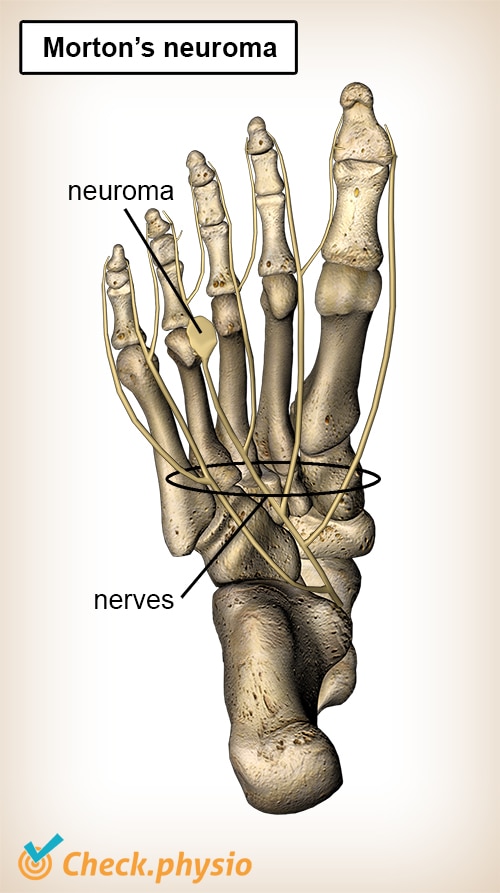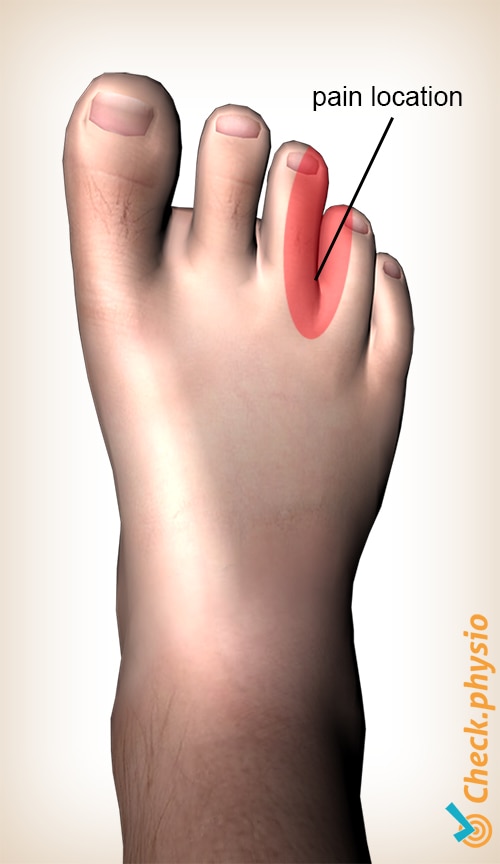Morton's neuroma
Morton's neuralgia, Morton's neurinoma, Morton's interdigital neuralgia
A Morton's neuroma is a localised thickening of a sensory nerve located between the toes. Usually this is between the third and fourth toe, counting from the big toe. This swelling is caused by increased pressure on the nerve.

A Morton's neuroma can cause pain and tingling that radiates to the toes. Walking, in particular, can be very unpleasant as a result. This disorder is named after the American surgeon Thomas Morton.
Description of the condition
Many nerve branches run through the foot, including between the tips of the metatarsals under the ball of the foot. That is where a Morton's neuroma can develop.
This condition involves an irritation of the nerve, which causes extra nerve tissue to form at that spot. Although this is a benign nerve proliferation, it can still cause unpleasant symptoms. Because it involves a sensory nerve, only sensation is affected in this condition. The motor functions remain intact, so there is no loss of muscle function.
A Morton's neuroma can develop in anyone at any age, but the condition is up to 10 times more common in women.
Cause and origin
A Morton's neuroma is caused by pinched and/or damaged nerves, usually between the 3rd and 4th toe. The cause of the entrapment is not always clear, but the condition is often seen in combination with a foot deformity such as a flat foot, splayed foot or hollow foot. Direct injury to the foot or nerve can also be a cause.
Wearing the wrong and overly tight shoes is an obvious risk factor, which can irritate or damage the affected nerve.
Signs & symptoms
Symptoms that can occur with a Morton's neuroma are: - Pain under the ball of the foot with possible radiation towards the toes. - Pain increases during weight-bearing or when wearing shoes that are (too) tight or high heels. - Insensitivity, numbness, prickling and/or tingling of toes. - Taking the strain off the foot reduces the symptoms. - Mostly present between the 3rd and 4th toe.
Diagnosis
Based on an interview, the doctor or physiotherapist will try to find out what the symptoms are and where they come from. Then a physical examination is carried out, during which local pressure pain and sensation are examined. This usually provides sufficient information to make the diagnosis of Morton's neuroma.
An ultrasound can confirm the diagnosis and at the same time visualise the size of the neuroma. Any additional examination, in the form of MRI or X-ray, can be used to identify other causes of pain in the foot and toes.
Treatment
A valuable tip is to wear footwear that is not too tight around the forefoot. It can also be useful to wear a foot orthosis to increase the space between the metatarsals and thus reduce the pressure on the nerve. A next step can be to get an injection with corticosteroids. Unfortunately, this often only works temporarily because it does not tackle the cause of the symptoms.
Surgery
If these non-surgical treatment methods do not help sufficiently, surgery can be considered. This involves removing the neuroma, with (part of) the nerve it is part of. This results in permanent numbness in the area that is innervated by this nerve.
Another option is to leave the neuroma where it is, but create more space to reduce the pressure on the neuroma. Afterwards, the annoying feeling caused by the neuroma often disappears.
The foot is fully healed again after six weeks. To prevent the complaints from recurring, it is important to wear proper shoes and possibly support the foot with an orthosis.
Exercises
Follow the specially compiled exercise programme with exercises for Morton's neuroma here.
You can check your symptoms using the online physiotherapy check or make an appointment with a physiotherapy practice in your area.

References
Brukner, P. & Khan, K. (2010). Clinical sports medicine. McGraw-Hill: Australia. 3e druk.
Brukner, P. & Khan, K. (2016). Clinical sports medicine (Nederlandse bewerking). 4th edition. Michel van Troost. PreVision, Eindhoven.
Verhaar, J.A.N. & Linden, A.J. van der (2005). Orthopedie. Houten: Bohn Stafleu van Loghum.



